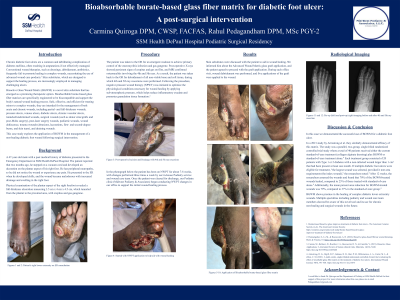Clinical Research
(CR-068) Bioabsorbable Borate-based Glass Fiber Matrix Usage in Diabetic Foot Wound Closure Post Surgical Intervention
Friday, May 2, 2025
7:45 PM - 8:45 PM East Coast USA Time

Rahul Pedagandham, DPM/Msc
Introduction:
47 year old male presented to the ED, and our service was consulted to see the patient for a diabetic foot infection. He is Diabetic with peripheral neuropathy so he states he never noticed the wound or causing any pain. He stated he went to the ER when he noticed the wound became malodorous with increased drainage and increased swelling to the right foot and had presented with some chills. He had presented with a plantar aspect right forefoot full thickness ulceration measuring 3.5 cm x 4 cm x 4.5 cm which tunneled plantar to proximal with crepitus and gas gangrene was noted in the foot.
Methods:
Patient was taken to the OR for an emergent washout for primary control of osteomyelitis infection and gas gangrene. X-rays were taken post-operatively and still there was some signs of crepitance noted and gas on film and MRI confirmed 4th and 5th rays consisting of osteomyelitis ,so he was taken again to the OR for debridement of all non-viable bone and soft tissue in which the second time 4th and 5th ray resections were performed. Then started NWPT post-operatively to optimize the physiology involved in wound healing by applying sub- atmospheric pressure to help reduce inflammatory exudate and promote granulation tissue
Patient has been on NWPT for about 7-8 weeks consisting of 3x weekly changes which were done with in house with our Podiatry service and wound care team.
Results: Skin substitutes were then discussed with patient to help achieve wound healing. Started to apply glass graft for our patient and patient agreed to proceed with the application of the graft. Each office visit, wound debridement was done and five applications of the graft were applied to the wound
Discussion:
Mirragen® Advanced Wound Matrix is intended for the management of acute and chronic wounds, including: partial- and full-thickness wounds, pressure ulcers, venous ulcers, diabetic ulcers, chronic vascular ulcers, tunneled/undermined wounds, surgical wounds (donor sites/grafts, post-Mohs surgery), post laser surgery, podiatric wounds, wound dehiscence, trauma wounds (abrasions, lacerations, first- and second-degree burns, skin tears), and draining wounds. With continued discussion of using this specific type of glass graft in healing complex diabetic lower extremity wounds in wound care and podiatry could lead to increased awareness and aid in potentially healing chronic non-healing wounds and surgical wounds the future.
47 year old male presented to the ED, and our service was consulted to see the patient for a diabetic foot infection. He is Diabetic with peripheral neuropathy so he states he never noticed the wound or causing any pain. He stated he went to the ER when he noticed the wound became malodorous with increased drainage and increased swelling to the right foot and had presented with some chills. He had presented with a plantar aspect right forefoot full thickness ulceration measuring 3.5 cm x 4 cm x 4.5 cm which tunneled plantar to proximal with crepitus and gas gangrene was noted in the foot.
Methods:
Patient was taken to the OR for an emergent washout for primary control of osteomyelitis infection and gas gangrene. X-rays were taken post-operatively and still there was some signs of crepitance noted and gas on film and MRI confirmed 4th and 5th rays consisting of osteomyelitis ,so he was taken again to the OR for debridement of all non-viable bone and soft tissue in which the second time 4th and 5th ray resections were performed. Then started NWPT post-operatively to optimize the physiology involved in wound healing by applying sub- atmospheric pressure to help reduce inflammatory exudate and promote granulation tissue
Patient has been on NWPT for about 7-8 weeks consisting of 3x weekly changes which were done with in house with our Podiatry service and wound care team.
Results: Skin substitutes were then discussed with patient to help achieve wound healing. Started to apply glass graft for our patient and patient agreed to proceed with the application of the graft. Each office visit, wound debridement was done and five applications of the graft were applied to the wound
Discussion:
Mirragen® Advanced Wound Matrix is intended for the management of acute and chronic wounds, including: partial- and full-thickness wounds, pressure ulcers, venous ulcers, diabetic ulcers, chronic vascular ulcers, tunneled/undermined wounds, surgical wounds (donor sites/grafts, post-Mohs surgery), post laser surgery, podiatric wounds, wound dehiscence, trauma wounds (abrasions, lacerations, first- and second-degree burns, skin tears), and draining wounds. With continued discussion of using this specific type of glass graft in healing complex diabetic lower extremity wounds in wound care and podiatry could lead to increased awareness and aid in potentially healing chronic non-healing wounds and surgical wounds the future.

.jpg)